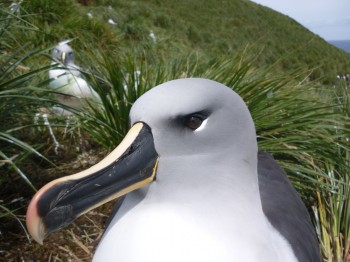 The stomach contents of Grey-headed Albatrosses Thalassarche chrysostoma (pictured) were analysed as part of the study. Monitoring of the diets of Grey-headed and Black-browed albatrosses has been continuous since the 1970s; photograph by Richard Phillips
The stomach contents of Grey-headed Albatrosses Thalassarche chrysostoma (pictured) were analysed as part of the study. Monitoring of the diets of Grey-headed and Black-browed albatrosses has been continuous since the 1970s; photograph by Richard Phillips
Richard Phillips (British Antarctic Survey, Natural Environment Research Council, UK) and colleagues have published open access in the journal Reviews in Fish Biology and Fisheries on the health and distribution of Patagonian lamprey populations inferred through an analysis of the diet of South Atlantic albatrosses.
The paper’s abstract follows:
“Knowledge of lampreys during their marine phase is limited, and for the southern hemisphere species was gleaned from their predators (albatrosses) in the 1970s. Taking advantage of new methodologies and long-term data on predator diet and distributions, we infer diverse aspects of lamprey distribution and ecology. DNA analyses indicated that albatrosses at South Georgia prey on Patagonian lamprey Geotria macrostoma, originating from Argentina. Their core pelagic distribution when free swimming appears to be the Antarctic Polar Frontal zone (APFZ), and not South Georgia waters as assumed previously. If so, the APFZ would be the first known hotspot in abundance of an anadromous lamprey in oceanic waters. We could not identify a teleost fish that would be a likely host. Instead, we infer that the lamprey may prey on baleen whales, based on comparison of stable isotope ratios in lamprey with candidate host species, timing of appearance in albatross diets coincident with whale migrations, and circumstantial evidence (unexplained scarring recorded during the whaling era). We suggest that the lamprey do not tolerate cold Antarctic waters, and detach from southerly-migrating whales at the thermal boundary of the APFZ, where they become accessible to albatrosses in surface waters. Given strong evidence that relative importance of prey in seabird diets reflects availability in foraging areas, the steep decrease in the annual consumption of lamprey by albatrosses at South Georgia from > 550 tonnes in 1975–1976 and 1986, to very low levels in most years since 2012, is likely to indicate a major population decrease. Despite our unconventional means of assessing the population trend, there is a compelling case for listing of Patagonian lamprey at least as Near threatened by the International Union for the Conservation of Nature, and an urgent need to better understand anthropogenic threats in Argentina.”
Reference:
Phillips, R.A., Waluda, C.M. & Miller, A.K. Distribution, hosts and long-term decline in abundance of the Patagonian lamprey inferred from diet assessment of albatrosses. Rev Fish Biol Fisheries (2023). https://doi.org/10.1007/s11160-023-09786-3
28 July 2023

 Français
Français  English
English  Español
Español